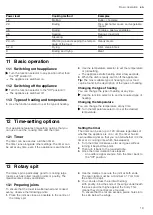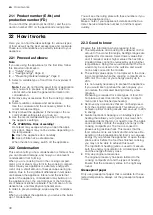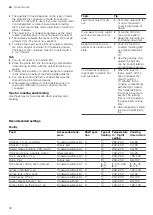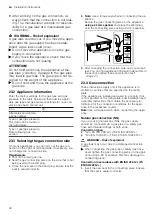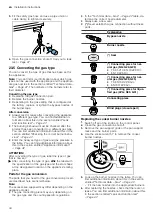
How it works
en
31
WARNING ‒ Risk of fire!
Opening the appliance door creates a draught.
Greaseproof paper may come into contact with the
heating element and catch fire.
▶
Do not place greaseproof paper loosely over ac-
cessories when preheating the appliance.
▶
Always use a plate or baking tin to hold greaseproof
paper down.
▶
Do not use more greaseproof paper than is neces-
sary.
▶
Greaseproof paper must not extend over the edge
of accessories.
22.4 Notes on baking
When baking, use the shelf positions indicated.
Baking on one level
Shelf posi-
tion
Rising pasta/baked goods or tin on the
wire rack
2
Flat pasta/baked items or in the baking
tray
2–3
Note:
For best results, we recommend using dark-col-
oured metal baking tins.
22.5 Cakes and other baked goods
Recommended settings for cakes and baked items
The temperature and baking time depend on the quant-
ity and consistency of the dough. This is why temperat-
ure ranges are given in the tables. Set a short cooking
time first. If required, set a longer cooking time next
time. A lower temperature results in more even brown-
ing.
Baking tips
We have compiled a few tips to help you achieve a
good baking result.
Topic
Tip
You want your cake to
rise evenly.
¡
Only grease the base
of the springform cake
tin.
¡
After baking, use a
knife to carefully
loosen the cake from
the baking tin.
You do not want small
baked goods to stick to
each other when baking.
Leave a minimum clear-
ance of 2 cm around
each item that is to be
baked. This allows
enough space for the
baked goods to expand
and brown on all sides.
Determine whether the
cake is ready.
Push a cocktail stick into
the highest point on the
cake. If the cocktail stick
comes out clean, the
cake is ready.
You want to bake accord-
ing to your own recipe.
Use similar items in the
baking tables as a guide.
Use bakeware made of
silicone, glass, plastic or
ceramic.
¡
The baking tin must be
heat-resistant up to
250 °C.
¡
Cakes in these types
of bakeware brown
less.
Recommended settings
Cakes in tins
Meal
Accessory/cookware Shelf posi-
tion
Type of
heating
Temperature
in °C
Cooking
time,
minutes
Sponge cake, simple
Vienna ring tin/loaf tin 2
160–180
50–60
Sponge cake, delicate
Vienna ring tin/loaf tin 2
150–170
60–80
Sponge flan base
Flan base tin
3
160–180
30–40
Fruit tart or cheesecake with shortcrust
pastry base
Springform cake tin,
diameter 26 cm
2
160–180
70–90
Strudel
Tart dish or tin
1
200–240
25–50
Pie
Springform cake tin,
28 cm diameter
2
160–180
25–35
Sponge cake
Bundt cake tin
2
150–170
60–80
Sponge flan, 3 eggs
Springform cake tin,
diameter 26 cm
2
160–180
30–40
Sponge flan, 6 eggs
Springform cake tin
Ø 28 cm
2
160–180
35–45



